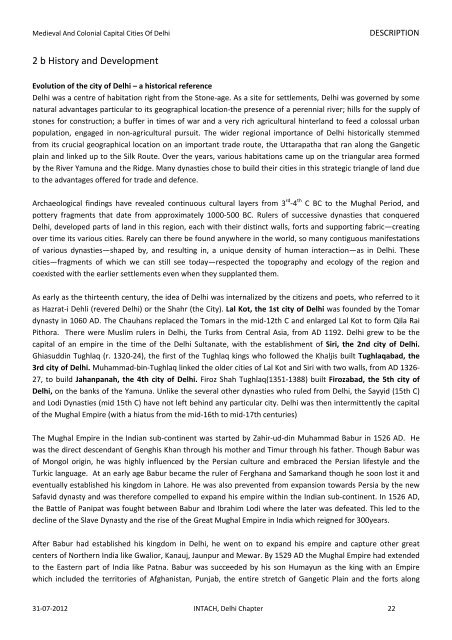Download - Delhi Heritage City
Download - Delhi Heritage City
Download - Delhi Heritage City
You also want an ePaper? Increase the reach of your titles
YUMPU automatically turns print PDFs into web optimized ePapers that Google loves.
Medieval And Colonial Capital Cities Of <strong>Delhi</strong>DESCRIPTION2 b History and DevelopmentEvolution of the city of <strong>Delhi</strong> – a historical reference<strong>Delhi</strong> was a centre of habitation right from the Stone‐age. As a site for settlements, <strong>Delhi</strong> was governed by somenatural advantages particular to its geographical location‐the presence of a perennial river; hills for the supply ofstones for construction; a buffer in times of war and a very rich agricultural hinterland to feed a colossal urbanpopulation, engaged in non‐agricultural pursuit. The wider regional importance of <strong>Delhi</strong> historically stemmedfrom its crucial geographical location on an important trade route, the Uttarapatha that ran along the Gangeticplain and linked up to the Silk Route. Over the years, various habitations came up on the triangular area formedby the River Yamuna and the Ridge. Many dynasties chose to build their cities in this strategic triangle of land dueto the advantages offered for trade and defence.Archaeological findings have revealed continuous cultural layers from 3 rd ‐4 th C BC to the Mughal Period, andpottery fragments that date from approximately 1000‐500 BC. Rulers of successive dynasties that conquered<strong>Delhi</strong>, developed parts of land in this region, each with their distinct walls, forts and supporting fabric—creatingover time its various cities. Rarely can there be found anywhere in the world, so many contiguous manifestationsof various dynasties—shaped by, and resulting in, a unique density of human interaction—as in <strong>Delhi</strong>. Thesecities—fragments of which we can still see today—respected the topography and ecology of the region andcoexisted with the earlier settlements even when they supplanted them.As early as the thirteenth century, the idea of <strong>Delhi</strong> was internalized by the citizens and poets, who referred to itas Hazrat‐i Dehli (revered <strong>Delhi</strong>) or the Shahr (the <strong>City</strong>). Lal Kot, the 1st city of <strong>Delhi</strong> was founded by the Tomardynasty in 1060 AD. The Chauhans replaced the Tomars in the mid‐12th C and enlarged Lal Kot to form Qila RaiPithora. There were Muslim rulers in <strong>Delhi</strong>, the Turks from Central Asia, from AD 1192. <strong>Delhi</strong> grew to be thecapital of an empire in the time of the <strong>Delhi</strong> Sultanate, with the establishment of Siri, the 2nd city of <strong>Delhi</strong>.Ghiasuddin Tughlaq (r. 1320‐24), the first of the Tughlaq kings who followed the Khaljis built Tughlaqabad, the3rd city of <strong>Delhi</strong>. Muhammad‐bin‐Tughlaq linked the older cities of Lal Kot and Siri with two walls, from AD 1326‐27, to build Jahanpanah, the 4th city of <strong>Delhi</strong>. Firoz Shah Tughlaq(1351‐1388) built Firozabad, the 5th city of<strong>Delhi</strong>, on the banks of the Yamuna. Unlike the several other dynasties who ruled from <strong>Delhi</strong>, the Sayyid (15th C)and Lodi Dynasties (mid 15th C) have not left behind any particular city. <strong>Delhi</strong> was then intermittently the capitalof the Mughal Empire (with a hiatus from the mid‐16th to mid‐17th centuries)The Mughal Empire in the Indian sub‐continent was started by Zahir‐ud‐din Muhammad Babur in 1526 AD. Hewas the direct descendant of Genghis Khan through his mother and Timur through his father. Though Babur wasof Mongol origin, he was highly influenced by the Persian culture and embraced the Persian lifestyle and theTurkic language. At an early age Babur became the ruler of Ferghana and Samarkand though he soon lost it andeventually established his kingdom in Lahore. He was also prevented from expansion towards Persia by the newSafavid dynasty and was therefore compelled to expand his empire within the Indian sub‐continent. In 1526 AD,the Battle of Panipat was fought between Babur and Ibrahim Lodi where the later was defeated. This led to thedecline of the Slave Dynasty and the rise of the Great Mughal Empire in India which reigned for 300years.After Babur had established his kingdom in <strong>Delhi</strong>, he went on to expand his empire and capture other greatcenters of Northern India like Gwalior, Kanauj, Jaunpur and Mewar. By 1529 AD the Mughal Empire had extendedto the Eastern part of India like Patna. Babur was succeeded by his son Humayun as the king with an Empirewhich included the territories of Afghanistan, Punjab, the entire stretch of Gangetic Plain and the forts along31‐07‐2012 INTACH, <strong>Delhi</strong> Chapter 22















